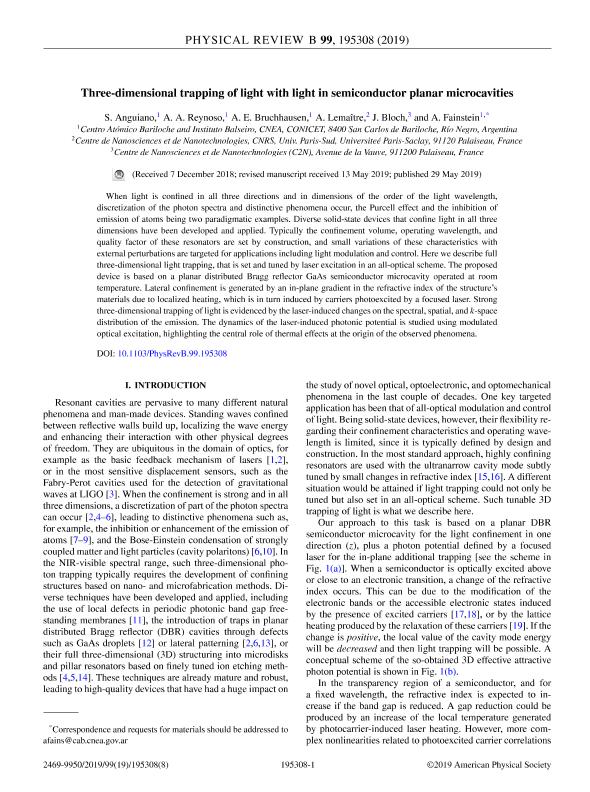Mostrar el registro sencillo del ítem
dc.contributor.author
Anguiano, Sebastian

dc.contributor.author
Reynoso, Andres Alejandro

dc.contributor.author
Bruchhausen, Axel Emerico

dc.contributor.author
Lemaître, A.
dc.contributor.author
Bloch, J.
dc.contributor.author
Fainstein, Alejandro

dc.date.available
2021-01-27T14:41:41Z
dc.date.issued
2019-05
dc.identifier.citation
Anguiano, Sebastian; Reynoso, Andres Alejandro; Bruchhausen, Axel Emerico; Lemaître, A.; Bloch, J.; et al.; Three-dimensional trapping of light with light in semiconductor planar microcavities; American Physical Society; Physical Review B; 99; 19; 5-2019; 1-8
dc.identifier.issn
2469-9969
dc.identifier.uri
http://hdl.handle.net/11336/123890
dc.description.abstract
When light is confined in all three directions and in dimensions of the order of the light wavelength, discretization of the photon spectra and distinctive phenomena occur, the Purcell effect and the inhibition of emission of atoms being two paradigmatic examples. Diverse solid-state devices that confine light in all three dimensions have been developed and applied. Typically the confinement volume, operating wavelength, and quality factor of these resonators are set by construction, and small variations of these characteristics with external perturbations are targeted for applications including light modulation and control. Here we describe full three-dimensional light trapping, that is set and tuned by laser excitation in an all-optical scheme. The proposed device is based on a planar distributed Bragg reflector GaAs semiconductor microcavity operated at room temperature. Lateral confinement is generated by an in-plane gradient in the refractive index of the structure's materials due to localized heating, which is in turn induced by carriers photoexcited by a focused laser. Strong three-dimensional trapping of light is evidenced by the laser-induced changes on the spectral, spatial, and k-space distribution of the emission. The dynamics of the laser-induced photonic potential is studied using modulated optical excitation, highlighting the central role of thermal effects at the origin of the observed phenomena.
dc.format
application/pdf
dc.language.iso
eng
dc.publisher
American Physical Society
dc.rights
info:eu-repo/semantics/openAccess
dc.rights.uri
https://creativecommons.org/licenses/by-nc-sa/2.5/ar/
dc.subject
confinement
dc.subject
light trapping
dc.subject
GaAs microcavity
dc.subject
thermal effects
dc.subject.classification
Física de los Materiales Condensados

dc.subject.classification
Ciencias Físicas

dc.subject.classification
CIENCIAS NATURALES Y EXACTAS

dc.title
Three-dimensional trapping of light with light in semiconductor planar microcavities
dc.type
info:eu-repo/semantics/article
dc.type
info:ar-repo/semantics/artículo
dc.type
info:eu-repo/semantics/publishedVersion
dc.date.updated
2020-12-16T18:22:07Z
dc.journal.volume
99
dc.journal.number
19
dc.journal.pagination
1-8
dc.journal.pais
Estados Unidos

dc.description.fil
Fil: Anguiano, Sebastian. Comisión Nacional de Energía Atómica. Unidad Ejecutora Instituto de Nanociencia y Nanotecnología. - Consejo Nacional de Investigaciones Científicas y Técnicas. Oficina de Coordinación Administrativa Ciudad Universitaria. Unidad Ejecutora Instituto de Nanociencia y Nanotecnología; Argentina
dc.description.fil
Fil: Reynoso, Andres Alejandro. Consejo Nacional de Investigaciones Científicas y Técnicas. Oficina de Coordinación Administrativa Ciudad Universitaria. Unidad Ejecutora Instituto de Nanociencia y Nanotecnología. Unidad Ejecutora Instituto de Nanociencia y Nanotecnología - Nodo Bariloche | Comisión Nacional de Energía Atómica. Unidad Ejecutora Instituto de Nanociencia y Nanotecnología. Unidad Ejecutora Instituto de Nanociencia y Nanotecnología - Nodo Bariloche; Argentina. Comisión Nacional de Energía Atómica. Gerencia del Área de Energía Nuclear. Instituto Balseiro; Argentina
dc.description.fil
Fil: Bruchhausen, Axel Emerico. Consejo Nacional de Investigaciones Científicas y Técnicas. Oficina de Coordinación Administrativa Ciudad Universitaria. Unidad Ejecutora Instituto de Nanociencia y Nanotecnología. Unidad Ejecutora Instituto de Nanociencia y Nanotecnología - Nodo Bariloche | Comisión Nacional de Energía Atómica. Unidad Ejecutora Instituto de Nanociencia y Nanotecnología. Unidad Ejecutora Instituto de Nanociencia y Nanotecnología - Nodo Bariloche; Argentina. Comisión Nacional de Energía Atómica. Gerencia del Área de Energía Nuclear. Instituto Balseiro; Argentina
dc.description.fil
Fil: Lemaître, A.. Centre National de la Recherche Scientifique; Francia
dc.description.fil
Fil: Bloch, J.. Centre de Nanosciences et de Nanotechnologies; Francia
dc.description.fil
Fil: Fainstein, Alejandro. Consejo Nacional de Investigaciones Científicas y Técnicas. Oficina de Coordinación Administrativa Ciudad Universitaria. Unidad Ejecutora Instituto de Nanociencia y Nanotecnología. Unidad Ejecutora Instituto de Nanociencia y Nanotecnología - Nodo Bariloche | Comisión Nacional de Energía Atómica. Unidad Ejecutora Instituto de Nanociencia y Nanotecnología. Unidad Ejecutora Instituto de Nanociencia y Nanotecnología - Nodo Bariloche; Argentina. Comisión Nacional de Energía Atómica. Gerencia del Área de Energía Nuclear. Instituto Balseiro; Argentina
dc.journal.title
Physical Review B
dc.relation.alternativeid
info:eu-repo/semantics/altIdentifier/doi/https://doi.org/10.1103/PhysRevB.99.195308
dc.relation.alternativeid
info:eu-repo/semantics/altIdentifier/url/https://journals.aps.org/prb/abstract/10.1103/PhysRevB.99.195308
Archivos asociados
